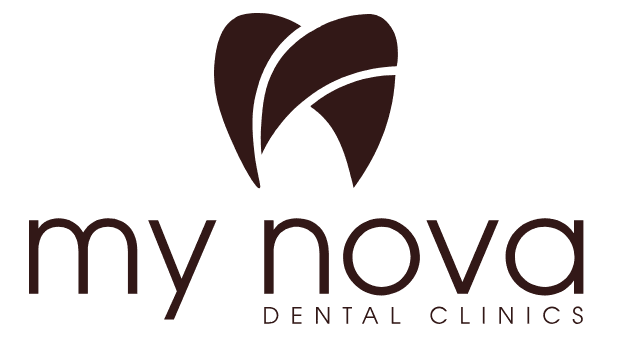TYPES OF RADIOGRAPHY APPLIED IN OUR CLINIC
PERIAPICAL RADIOGRAPH (PERIAPICAL X-RAY)
Feature: A small, detailed imaging method that shows only one or a few adjacent teeth. The film or sensor is placed inside the mouth.
What It Shows: It clearly displays the entire tooth crown (visible part), the root, and the surrounding bone and periapical tissue (periodontium).
Purpose of Use: Used to diagnose specific problems in one or several teeth in a certain region (e.g., cavity depth, root tip infection, or root canal success).
PANORAMIC RADIOGRAPH (PANORAMIC X-RAY)
Feature: An extraoral imaging method. The device rotates 180 degrees around the patient’s head.
What It Shows: Displays all teeth, jawbone, and surrounding anatomical structures in a single image. Provides information about jawbone health, impacted wisdom teeth, sinuses, and jaw joints.
Purpose of Use: Ideal for scanning large areas, orthodontic evaluation, and general treatment planning before major prosthetic or implant procedures. Its resolution is lower than that of periapical radiographs.
DENTAL TOMOGRAPHY (CBCT - CONE BEAM COMPUTED TOMOGRAPHY)
Feature: An extraoral three-dimensional (3D) imaging technique that emits a cone-shaped beam.
What It Shows: Provides cross-sectional, volumetric images showing the actual size and volume of teeth, jawbones, nerve canals, and anatomical structures. Bone thickness, height, and width can be measured precisely in millimeters.
Purpose of Use: Provides true three-dimensional information not available from the other two methods. Indispensable for complex implant surgeries, bone grafting procedures, and surgical planning for impacted teeth. Since this method involves the highest radiation dose, it is used only when necessary.
GENERAL INFORMATION
Patient Admission and Preparation
- During our comprehensive examination, we collect information about your general health and any medications you regularly use, perform your oral examination, assess your treatment expectations, and request radiographic imaging when necessary.
- Informing your dentist about your medical conditions, allergies, medications, pregnancy, or significant past illnesses is essential for your safety.
- For example, if you have allergic tendencies, an allergy test may be required before anesthesia. If you use aspirin for blood thinning, your dentist may ask you to discontinue it before surgery.
- Existing health issues or medication use do not prevent dental treatment. On the contrary, knowing these allows your dentist to plan the safest and most comfortable treatment for you. Consultations with other departments may be required when needed, and you will be informed about such processes.
- If you experience dental anxiety (dental phobia) or sensitivity, please let us know. We can take additional measures (e.g., sedation, general anesthesia) to ensure a comfortable experience. In such cases, consultations with our relevant specialists and anesthesiologists are arranged.
- Dental treatment is personalized. Our priority is to create the safest and most appropriate treatment plan for you.
- For patients admitted for radiographic imaging, registration and requests are verified through the Hospital Information Management System (SBYS).
- Patients with incomplete or incorrect documentation are directed to contact the requesting department.
- Patient identity verification is performed before imaging.
- Procedures are explained to patients, questions are answered, and suitability for imaging (e.g., pregnancy) is evaluated.
- Priority is given to patients who require urgent or special consideration.
- Patients are required to sign the “Oral and Maxillofacial Radiology Informed Consent Form.”
- Patients are asked to remove metal items such as jewelry, pins, or hair accessories before imaging.
- Personal belongings are stored securely in a locked cabinet.
- Lead protective equipment (apron, etc.) is provided and must be worn during imaging.
Appointment Process
- No appointment system is applied after radiographic or CBCT (Cone Beam CT) imaging is performed.
- Pediatric, disabled, and emergency patients are given appointment priority.
Result Delivery Process
- Radiographic results are recorded under the patient’s file and instantly transferred to the Hospital Information Management System (SBYS) through the PACS system.
- Patients or relatives are informed that the results can be reviewed by their physician in the relevant clinic or department.
- The attending physician evaluates all imaging results.
- If imaging is deemed unsatisfactory, it is repeated with a new radiology request.
Imaging Procedure
- Patients are imaged based on physician-approved requests registered in the SBYS system.
- Patients are called for imaging in order of registration.
- Patients are informed about the procedure and positioning before imaging.
- For patients whose registration and preparations are complete, materials (lead apron, thyroid protector) are used for patient safety. Patients are brought to the imaging room to be equipped according to Radiology Personal Protective Equipment (PPE) Guidelines.
- Proper and calibrated devices are used, and patients are asked to remove any removable or artificial items (jewelry, prosthetics) to ensure safety. These items are stored appropriately.
- Patients are positioned correctly, and necessary instructions are provided before imaging.
- After radiography, PPE (lead apron and thyroid protector) is disinfected and stored without folding. Care is taken to avoid folding protective equipment.
- During use and storage, protective equipment is handled carefully to prevent cracking, folding, or perforation. If there is any doubt, the equipment is not used, and the Radiology Services Responsible Physician is informed.
- After the procedure, PPE is cleaned with proper attention, and pre-use checks are conducted. If needed, supportive equipment is provided depending on patient condition (e.g., pregnancy).
- Protective equipment (lead apron, thyroid protector) is checked annually, and results are recorded.
Radiation Protection for Patients and Relatives
- Adequate numbers and sizes of protective equipment (thyroid protector, lead apron) are provided in imaging units.
- All patients undergoing imaging are required to wear PPE.
- Pregnant patients or those suspected of being pregnant are warned verbally and in writing. Protective measures are applied to protect the fetus.
Radiation Protection for Staff and PPE Practices
- The Radiology Department follows the Radiation Safety Procedure.
- Staff receive regular training on radiation safety from the Radiology Services Responsible Physician.
- Staff wear dosimeters every three months, monitored by the Nuclear Regulatory Authority, and results are reported. Dosimeter readings and health checks are reviewed regularly. Radiation doses are compared with legal limits periodically and annually.
FREQUENTLY ASKED QUESTIONS
What is the purpose of X-rays?
- It is now an indispensable diagnostic tool for medical professionals.
- The most commonly used diagnostic method.
- X-rays allow the doctor to contribute to diagnosis without touching or disturbing the patient.
- Used to evaluate trauma, fractures, hidden dental pathologies, and the position of impacted teeth within the jaw.
- It is essential when conditions cannot be clinically assessed inside the mouth or when evaluation inside the jawbone is required.
- Not all dental issues can be seen without X-ray imaging.
- Many issues (hidden cavities, bone loss due to gum disease, infections at the roots) can only be detected with X-ray films.
- Taking 12-14 X-ray images in a single session for the whole mouth is not harmful.
When do you need to have an X-ray?
- For diagnosis and treatment planning
- During treatment
- For post-treatment follow-up
- To monitor lesions periodically
Do dental X-rays increase the risk of leukemia or thyroid cancer?
The risk for leukemia depends on the amount of tissue irradiated and the dose.
Dental X-rays involve only a very small part of the active bone marrow in the maxilla and mandible.
Approximately 2000-8000 periapical X-rays would be required to cause leukemia.
Thyroid exposure is possible even if the thyroid is not directly in the primary X-ray beam.
However, the dose to the thyroid during dental radiography is much lower than in medical imaging (CT, mammography, etc.).
Thyroid protection with a lead collar is recommended during dental X-rays.
How much does a lead apron reduce radiation?
- A standard 0.5 mm lead apron reduces the patient’s radiation exposure by approximately 95%.
Can oral symptoms indicate systemic disease?
- Yes. Symptoms such as bleeding, bad odor, numbness, or burning may be due to oral or systemic issues. Always consult your dentist.
Can I have a dental X-ray during pregnancy?
- Avoid X-rays unless necessary. If needed, always wear a lead apron.
How often should I have dental check-ups?
- Regular check-ups are crucial for early diagnosis. Brushing alone does not guarantee problem-free teeth. It is recommended to visit your dentist at least twice a year.
Can thyroid protection be used for all dental X-rays?
- Thyroid protection is important, but may not be suitable during certain orthodontic or panoramic imaging if it interferes with the image.
Important information for patients
- Clinic hours: Weekdays 09:00-19:00, Saturday 09:00-18:00.
- A signed Patient Consent Form is required before any X-ray.
- Pregnant patients must inform their physician and radiology staff. Accompanying persons are not allowed in the imaging room.
- Avoid wearing metal accessories during your visit.
- Remove all removable dental prosthetics and leave them safe. Never leave them with strangers.
- If film quality is insufficient, imaging will be repeated promptly.
- For any questions, contact the Reception Desk.
For expectant mothers:
- Inform your doctor if you are pregnant or may be pregnant. Obtain X-ray approval if required.
- All X-ray procedures involve potential benefits and risks. Your doctor will assess this before imaging.
- During pregnancy, a lead apron may be placed over the abdomen to protect the fetus.
- The Radiation Authority (TAEK) can calculate fetal radiation exposure if necessary.


